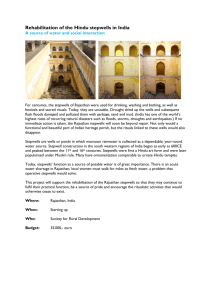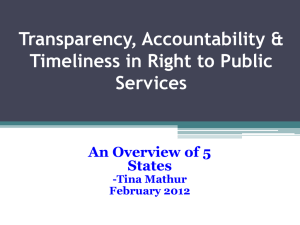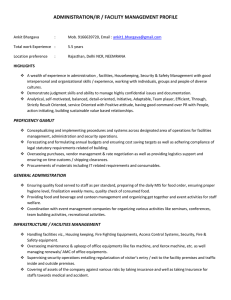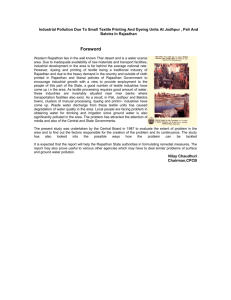Staple food sector Presentation by
advertisement
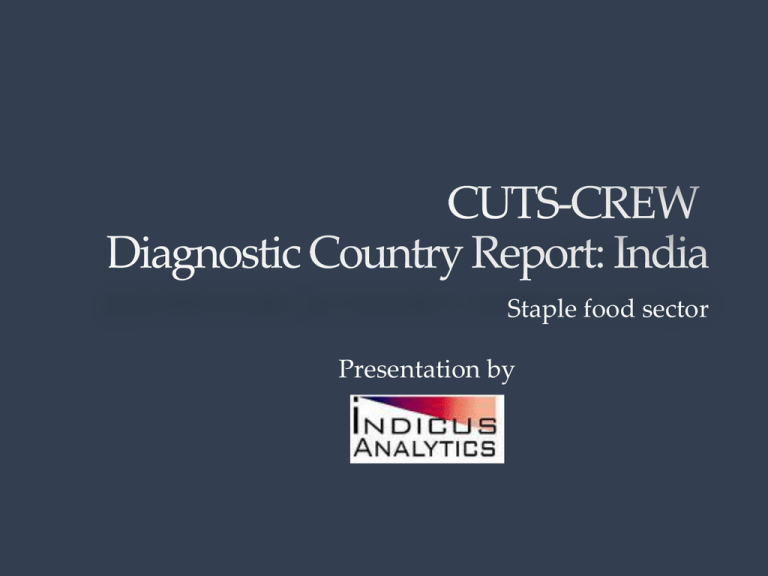
Staple food sector Presentation by Background Objectives of the project Selection of Focus Sectors Selection of Focus Sectors Methodology – desk based research i. ii. Literature review, Discussion with experts of competition policy, reform initiatives, iii. Collection and analysis of secondary data iv. Stakeholder identification v. Selection of impact/welfare issues to be covered , hypothesis formation vi. Selection of variables on which data to be collected, identification of data sources vii. Development of questionnaires for perception survey, viii. Development of guidelines for in-depth interview ix. Finalisation of sampling framework Methodology – field visits i. Data collection from govt. officials dealing with specific sector • Not all information available readily from secondary sources • Especially, in case of bus transport ii. Perception survey of producers and consumers • To obtain the feedback on issues relevant to the stakeholders iii. In-depth interview of stake holders • To understand the perspective of stakeholders in respect of • general operational aspects of the sector, as well on • competition. Criterion for selection of States - Wheat Selection of States - Wheat • Rajasthan and Bihar Perception survey sampling Sample size: 400 respondents - 200 farmers, 200 consumers from each state. States: Rajasthan and Bihar Districts: From amongst the top and middle wheat producing districts. 100 farmers, 100 consumers from each of the districts. Rajasthan: Alwar, Bhilwara. Bihar: Saran, Vaishali. From each districts, two blocks were covered (50 farmers from each block) From each block, two villages were covered (25 farmers from each block) Farmer sample selection at village level was stratified random. 5 samples were drawn from each of the following 5 land holding based categories Marginal (<1 hectare) Small (1 to 2 hectare) Semi medium (2 to 4 hectare) Medium ( 4 to 10 hectare) Large (>10 hectare) Consumers were sampled randomly from the urban areas/ district headquarter of districts where farmers were surveyed. Shortlisted reforms and issues for investigation - Wheat Reform Area Production Procurement Reform/issues in question Issues for investigation Various administrative and/or Industry structure legislative measures with impact Input availability, provider on input availability, quality, cost, Cost of cultivation, production, etc. input Area under production, output, yield, etc. Establishment of State Volume procured Government monopoly in Base price for procurement procurement of wheat in Bihar Comparison of wholesale prices vide notification dated 15.04.2013 to procurement price Decentralised Procurement System introduced in Rajasthan for wheat procurement Shortlisted reforms and issues for investigation - Wheat Reform Reform/issues in question Issues for investigation Area Warehousing Warehouse Development and Number of providers, nature Regulatory Act 2007 providers Private Entrepreneurship Capacity of storage Guarantee Scheme 2008 Capacity utilisation Rural Godown Scheme 2001 Agricultural Marketing of Repealing of APMC Act by Bihar in Impact on the stakeholders in the 2006; wheat supply chain Amendment of APMC Act by Rajasthan in 2005 to bring it in line with Model APMC Act Shortlisted reforms and issues for investigation - Wheat Reform Reform/issues in question Area Distribution PDS and Open market control measures marketing Issues for investigation Retail price Expenditure on wheat Distribution through TPDS Subsidy Competition framework Competition framework – Staple food, wheat NUMBER OF PLAYERS Production Farmers • • • Large number of farmers Most are marginal or small Share in production of each farmer is very small, with no market power Production Input markets (Fertilizer) • There are 30 large size fertilizer plants in the country manufacturing urea, 21 units produce DAP and complex fertilizers, 5 units produce straight nitrogenous fertilizers and the 2 units manufacture ammonium sulphate as by-products. • Out of 30 urea units set up between 1967 – 2005, 14 were in the Private sector. There are around 15 Private companies producing urea, and 11 Private companies producing phosphate based fertilizers. • In Urea, there are another 6 Public sector companies and 2 Cooperatives. • In Phosphate, apart from Private companies, there are another 4 Public sector companies and 1 Cooperative. Besides, there are about 85 medium and small-scale units in operation producing Single Super Phosphate fertilizers. • • Competition framework – Staple food, wheat NUMBER OF PLAYERS Production Input markets (Seed) • • • Production Input markets (Credit) • • • Around 500 private seed producers are there. The opening up the seed sector has also led to significant FDI and participation of multinational firms • Around 35-50 of the private firms have foreign collaboration. Apart from the private producers, there are National Seeds Corporation and 15 State Seed Corporations. Bihar: • 39 commercial banks are present in Bihar. • There were 2181 rural banked centres (total 2623) with 2350 rural offices of scheduled commercial banks (total 3909). Rajasthan: • 55 commercial banks are present in Rajasthan. • There were 1626 rural banked centres (total 1914) with 1756 rural offices of scheduled commercial banks (total 4042). However, with rural credit being largely dictated by Government policy, larger presence does not imply better competition. Competition framework – Staple food, wheat NUMBER OF PLAYERS Procurement • • • • Procurement for maintaining buffer stock/ food security purposes is entirely handled by Government agencies. • There exists a number of national entities like Food Corporation of India (FCI), National Agricultural Cooperative Marketing Federation of India (NAFED), etc. • In addition, there are a number of state bodies like Rajasthan State Co-operative Marketing Federation Ltd (RajFED) in Rajasthan, Madhya Pradesh State Cooperative Marketing Federation Limited (MP MARKFED) in MP, Bihar State Food & Civil Supplies Corporation Limited in Bihar etc. • In Bihar, the Primary Agriculture Cooperative Societies (PACS) have been involved in wheat procurement. • In Rajasthan, Kray Vikray Sahkari Samiti (KVSS), a cooperative society of farmers at block level, is involved in wheat procurement. Number of procuring agencies for a particular crop in an area/ district is limited. Procurement takes place largely at the MSP plus any additional incentive or bonus markup declared on it by the state. Mostly operates based on a preset target, with no cross agency competition. Bihar - Procurement though state agencies only • Primary Agriculture Cooperative Societies (PACS) in Bihar • There were earlier 7 procurement agencies involved in procurement of wheat. • Since Ravi Marketing Season 2013-14, it has been pruned down to two – PACS and the nodal agency Bihar State Food Corporation. • PACS purchases from the farmers and sells it to BSFC, who in turn delivers it to FCI along with its own procurement from its purchase centers. • The farmers’ experience with PACS however raises a few points • Farmers need to submit land ownership records. Issued by tehsil office, but requires time of at least a month. • Creates additional hurdle in case ownership in official records remains with ancestors. • Refusals to purchase citing quality issues quite common. • A ‘broker’ segment has emerged – who purchases from farmers at a discounted price and sells it to PACS • Paper work completed by arranging documents through internal channels • Politically influenced • No system of performance audit • Bias towards paddy. • Limited alternate channels – BSFC purchase centres are generally at block level. Competition framework – Staple food, wheat NUMBER OF PLAYERS Warehouse • Though private sector are being encouraged to enter the warehouse sector, as of now it is dominated by Food Corporation of India (FCI), Central Warehousing Corporation (CWC) and State Warehousing Corporation (SWC). • These three together accounted for ~60% of the national capacity. • Fragmented private players accounts for barely 17% of capacity. S.No. Name of the Organization /Sector Storage Capacity in Million MTs Share in total 1. Food Corporation of India (FCI) 32.05 29% 2. Central Warehousing Corporation (CWC) 10.07 9% 3. State Warehousing Corporations (SWCs) 21.29 20% 4. State Civil Supplies 11.30 10% 5. Cooperative Sector 15.07 14% 6. Private Sector 18.97 17% Total 108.75 100% Competition framework – Staple food, wheat NUMBER OF PLAYERS Marketing • Rajasthan • APMC Act limits the number of markets authorized for trading in select agricultural crops. • Currently there are around 130 APMCs and 307 market sub-yards under these APMCs. • In addition, the Act also mandates transaction between buyers and sellers to be conducted though licensed commission agents. • License generally requires shop at the mandi yard. • As space is limited, effectively number of such licenses issued are also limited. • This gives the commission agents a degree of market power. • Though post reform, the Act allows direct purchase from farmers, it has not been successful. • Small land holding, small individual output. • Same has been the case with contract farming. • The millers are not always quality conscious – lower price is the main attraction. • Private market places have also not flourished – only 2-3 in the pipeline. • Land acquisition • Logistics – especially connectivity • Large investment with low incentives (20% of fees) Competition framework – Staple food, wheat NUMBER OF PLAYERS Marketing • Bihar • APMC Act was repealed in 2006. • No market regulator – no control over trade practices • No market fee are charged from the farmers But other charges for loading/unloading/Hamal charges are vogue/uncontrolled. • There are around 53 markets having basic infrastructure as open / covered platform, shops, godowns, weighbridge, etc. • The repeal of the Act freed the market for private participation. • However, in the absence public investment in infrastructure, it failed to attract significant private investment. • Limited private mandis, informal mandis • Underdeveloped marketing setup • Limited entry by players such as ITC, Britannia, etc., who are procuring wheat directly from farmers. Competition framework – Staple food, wheat ENTRY – EXIT; BARRIERS TO ENTRY Production – Inputs (Fertilizer) • • • • Production – Inputs (Seeds) • • Regulated price and supply of key inputs like natural gas • The GoI's new investment policy for debottlenecking brownfield and greenfield urea projects has not picked up due to concerns on urea offtake, high prices of gas, etc.. Govt. control over pricing and distribution of fertilizer along with decision to import. Highly capital extensive nature and stringent government policies. Delay in settling subsidy claims. • Delay in the issue of sales certification by the state governments • Issuance of bonds in lieu of cash payments -> imposes liquidity constraints, increases cost of finance. No significant barrier • Already around 500 private players, • 100% FDI, 35-50 companies with foreign collaboration However, profit margin significantly determines the areas of operation • Mostly active in high value – low volume agri products • Dominant player in maize, sunflower , cotton, vegetable seeds, horticultural crops, etc. • High volume – low margin crops of wheat, paddy, other cereals, oilseeds and pulses are dominated by public sector. Private sector fertilizer output Stagnating to declining private sector fertilizer output 14.0 12.0 11.6 11.4 11.3 10.9 12.4 12.3 12.2 11.9 10.9 in million tonne 10.0 8.0 6.0 5.5 5.4 5.4 4.1 4.0 2.9 4.5 4.2 2.9 5.0 4.8 4.3 3.8 3.2 2.7 5.7 5.5 5.4 5.5 4.2 4.1 3.9 3.5 2.9 2.7 2.4 2.5 2.4 2.0 0.0 2004-05 2005-06 2006-07 2007-08 2008-09 2009-10 2010-11 Nitrogen(N) fertilizer Private Sector Nitrogen(N) fertilizer Total Phosphate(P) fertilizer Private Sector Phosphate(P) fertilizer Total 2011-12 2012-13 Private seed production Private sector seed companies show lower volume growth, as a result of their presence being largely confined to low volume high margin agri products 180 171 47 47 45 160 43 40 140 39 40 35 115 120 45 151 41 112 109 30 100 100 79 77 80 69 63 80 25 83 69 20 63 60 15 40 10 20 5 - 2003-04 2004-05 2005-06 Private sector production 2006-07 Public sector production 2007-08 2008-09 Share of private sector (%) 2009-10 IN % IN LAKH QUINTAL 50 Competition framework – Staple food, wheat ENTRY – EXIT; BARRIERS TO ENTRY Warehouse • • • Regulated private entry allowed – requires permission from various government bodies A number of schemes to enhance private participation • Private Entrepreneurs Godown (PEG), 2008 scheme • Gramin Bhandaran Yojana (Construction of Rural Godowns) • Scheme for Financing Warehousing Infrastructure under Rural Infrastructure Development Fund (RIDF) • Capacity Building Programme in Warehousing Sector • Financial support to Public Private Partnership (PPP) in Infrastructure Constraints and Impediments • Capital intensive sector • Land requirements for constructing • Warehousing has not been accorded the status of full-fledged infrastructure • Storage charges not attractive • Shortage of trained manpower • Lack of adoption of modern technology FCI, CWC, SWC godown capacity and utilization FCI State Time CWC COVERED CAP TOTAL SWC COVERED CAP TOTAL COVERED CAP Grand Total TOTAL CAPACITY (LAKH TONNE) Bihar Raj 01-02-12 6.09 1 7.09 1.19 0 1.19 2.62 0 2.62 10.9 01-01-14 6.3 1 7.3 1.21 0 1.21 2.91 0 2.91 11.42 01-02-12 15.77 6.08 21.85 3.99 0.2 4.19 7.86 0 7.86 33.9 01-01-14 22.11 4.33 26.44 4.27 0.46 4.73 9.48 0 9.48 40.65 UTILIZATION (%) Bihar Raj 01-02-12 34 95 81 01-01-14 56 88 90 01-02-12 83 89 92 01-01-14 83 103 95 Statewise capacity completed by CWC, SWCs & private investors under PEG scheme as on 31.01.2014 (in lakh tonne) Sl. Centre No. 1 2 3 4 5 6 7 8 9 10 11 12 13 14 15 16 17 18 19 Punjab Haryana Uttar Pradesh Maharashtra Madhya Pradesh Chhattisgarh Karnataka Odisha Andhra Pradesh Rajasthan Tamilnadu Jammu & Kashmir Bihar Jharkhand Gujarat West Bengal Kerala Himachal Pradesh Uttarakhand Total Capacity approved by HLC 49.99 39.53 32.96 7.00 23.67 5.43 3.55 3.75 4.51 2.50 3.45 3.62 9.40 4.75 1.00 6.44 0.55 1.43 0.25 203.76 Capacity for which tenders sanctioned/ allotted 43.02 35.45 14.46 5.88 19.37 5.41 3.50 3.00 4.01 2.50 2.95 3.28 5.75 1.88 0.50 1.50 0.05 0.38 0.10 152.98 Capacity under Total completed construction capacity 5.33 9.15 5.82 0.58 10.89 2.04 0.25 0.43 1.82 0.57 0.50 0.92 0.48 0.75 0.32 0.35 0.10 40.28 37.20 22.68 7.84 5.30 4.01 3.16 2.88 2.09 2.00 1.63 1.05 0.70 0.67 0.50 0.50 0.27 0.05 0.03 92.55 Progress of rural godown scheme (as on 31st March 2014; cumulative figures) Sl. State No. 1 Andhra Pradesh No. of projects 1726 No. of projects 266 Capacity in tonnes 724,806 2 Madhya Pradesh 3127 6,981,671 16 Bihar 976 465,616 3 Punjab 1671 6,291,363 17 Jharkhand 16 79,918 4 Haryana 2174 6,205,438 18 Kerala 211 72,653 5 Maharashtra 3037 4,845,976 19 Jammu & Kashmir 7 35,648 6 Uttar Pradesh 1064 4,731,145 20 Himachal Pradesh 71 22,347 7 Gujarat 9293 3,029,714 21 Meghalaya 16 21,012 8 Karnataka 4251 2,933,085 22 Tripura 2 7,340 1,646,450 23 Arunachal Pradesh 1 945 9 Chhatisgarh 519 Capacity Sl. State in tonnes No. 7,337,677 15 Assam 10 Rajasthan 1242 1,508,474 24 Mizoram 1 756 11 West Bengal 2467 1,352,308 25 Goa 1 299 12 Tamilnadu 1037 1,110,793 26 Nagaland 2 250 0 - 33859 50,968,730 13 Uttarakhand 265 784,677 27 UTs 14 Orissa 416 778,369 Total Competition framework – Staple food, wheat ENTRY – EXIT; BARRIERS TO ENTRY Marketing • • The existing provisions of the APMC Act in Rajasthan requires licensed commission agents as intermediary between buyers and farmers in any trade • General precondition to license is ownership of shop/warehouse within mandi area • Limited mandi area, limited number of such shops/warehouses • Limited number of such commission agents, despite increasing agricultural output • Enables cartelization and malpractices The reform in APMC Act/ repeal of the Act in Bihar has enabled greater private participation in contract farming, direct marketing, private mandis. • The actual participation though have been slow. Some reasons are • Small agricultural land holding, low production • Lack of transparency in contracting process • Lack of sanctity of the contract • Lack of public investment in infrastructure • Lack of protection for crop failure, crop insurance • Problem with land acquisition • Credit availability and cost issues Competition framework – Staple food, wheat PRICE DISCOVERY Procurement, Marketing, Flow of information, Infrastructural bottlenecks • • • • Even though the price of agricultural produces are not regulated directly, many of the government interventions significantly affect price discovery through market • Procurement activity in certain items like wheat, rice, etc. • Policy of declaring Minimum Support Price • Restriction on movement, imports-exports • Designated market places, intermediaries Large scale procurement and storage has shrunk the scope of private sector in the market of these staple foods Extension services are weak – information flow on seeds, weather, prices, markets, etc. is not efficient Lack of access to markets • Large number of marginal/small farmers far away from the market. Wheat procurement 2500 45000 2000 30000 25000 1500 22514 20000 16355 476 539 11066 9300 10000 183 135 217 500 15000 557 772 1000 5000 0 0 0 0 1984-85 1990-91 2000-01 2010-11 2011-12 2012-13 AXIS TITLE Bihar Rajasthan All India '000 TONNE 28335 1303 35000 43 '000 TONNE 40000 1964 38148 Actual buffer stock holding in excess of stipulated minimum 35 30 30 29 25 23 22 22 IN MILLION TONNE 20 17 15 17 17 13 13 14 13 17 14 14 12 10 9 10 8 8 7 6 5 5 (1) 1st April 1st July 1st October 1st January (5) 2008-2009 2009-2010 2010-2011 2011-2012 2012-2013 2013-2014 Stipulated 1st April 1st July 1st Oct 1st Jan minimum holding norm 7 20.1 14 11.2 (in mn tonne) Minimum Support and Wholesale Price of Wheat MSP vs April-June average wholesale price of wheat 1800 1600 1400 IN RS/QUINTAL 1200 1000 800 600 400 200 0 MSP Bihar Rajasthan Production, Area under cultivation and yield PRODUCTION • • Bihar • Increased from 2,306,000 tonne in 1980-81 to 4,787,000 tonne in 2011-12. • CAGR of 2.38%, lower than the national average of 3.11%. Rajasthan • Increased from 2,394,000 tonne in 1980-81 to 9,320,000 tonne in 2011-12. • CAGR of 4.48%, considerably higher than the national average of 3.11%. AREA UNDER CULTIVATION • • Bihar • Increased from 1,755,000 hectare in 1980-81 to 2,170,000 hectare in 2011-12. • CAGR of 0.69%, lower than the national average of 0.95%. Rajasthan • Increased from 1,635,000 hectare in 1980-81 to 2,935,000 hectare in 2011-12. • CAGR of 1.91%, double the national average of 0.95%. YIELD Bihar o Increased from 1,314 kg/hectare in 1980-81 to 2,206 kg/hectare in 2011-12. o CAGR of 1.69%, lower than the national average of 2.14%. Rajasthan o Increased from 1,464 kg/hectare in 1980-81 to 3,175 kg/hectare in 2011-12. o CAGR of 2.53%, higher than the national average of 2.14%. Production of wheat – cost of inputs Inflation in agricultural input prices (Farm inputs Index Number of Whole Sale Prices, base 2004-05=100) Month/Year 1990-91 1999-00 2000-01 2009-10 2010-11 2011-12 2012-13 Fertilisers 31.85 85.61 93.22 110.00 119.20 137.20 151.30 Electricity (Irrigation) 23.03 60.70 75.99 118.10 127.20 136.80 168.00 Pesticides 47.02 83.76 85.49 111.40 113.60 116.00 121.90 Non-electical Machinery 43.69 76.58 80.93 116.50 120.50 123.70 123.10 Tractors 45.23 85.42 88.14 123.30 127.90 137.90 142.60 Lubricants 30.26 70.93 76.33 177.80 200.30 235.30 247.90 High Speed Diesel (HSD) 20.43 53.24 66.24 138.10 153.90 167.80 191.50 Light Diesel Oil (LDO) 18.15 53.41 68.26 172.50 208.60 259.20 273.60 Fodder 51.30 60.30 63.15 156.90 189.10 195.90 235.80 Cattle Feed 44.06 103.72 103.13 170.80 179.70 190.30 218.70 Cost of cultivation Cost of cultivation Cost of cultivation Bihar ITEMS Rajasthan 1996-97 2000-01 2010-11 1996-97 2000-01 2010-11 Cost of Cultivation per hect. (Rs.) 10,921 14,512 24,599 14,879 18,308 32,681 423 507 772 394 508 689 Seed (Kg.) 114 115 113 144 151 151 Fertilizer (Kg. Nutrients) 114 135 126 110 110 133 2 2 0 8 3 3 Human Labour (Man hrs.) 601 513 479 589 551 464 Animal Labour (Pair hrs.) 107 48 32 31 35 6 Cost of Production per qtl. (Rs.) Input Qty. per Hect. Manure (Qtl.) Breakup of cost of cultivation Bihar ITEMS Rajasthan 1996-97 2000-01 2010-11 CAGR 1996-97 2000-01 2010-11 CAGR 6,713 9,109 17,544 7.10% 9,567 12,106 18,855 4.97% Human Labour 2,084 2,681 6,273 8.19% 3,836 4,836 8,437 5.79% Bullock Labour 834 0.02% 423 524 132 -1.22% Machine Labour 653 1,932 3,397 12.50% 1,470 1,799 3,400 6.17% Seed 769 928 2,005 7.09% 1,090 1,259 2,352 5.65% Fertilizer & Manure 1,372 1,740 2,057 1,419 1,367 2,096 Insecticides 0 - - 5 13 17 Irrigation Charges 831 1,086 2,549 1,131 2,057 2,053 Miscellaneous - - - - - - Interest on Working Capital 170 6.80% 193 251 369 4.75% 3.54% 5,312 6,202 12,776 6.47% Operational Cost Fixed Costs 4,180 507 837 236 426 4,934 6,804 8.34% 4.35% Wheat consumption habit Commodities Year Rice Qty. consumed per Annum (in kg) Rural Urban 1993-94 82.61 62.42 2004-05 77.62 57.31 2009-10 74.7 56.64 1993-94 52.56 54.02 2004-05 50.98 53.05 2009-10 53.03 52.82 Coarse cereals 1993-94 27.86 12.53 2004-05 18.86 10.59 2009-10 10.34 4.6 1993-94 163.03 128.97 2004-05 147.46 120.94 2009-10 138.08 114.05 All pulses & 1993-94 Pulse Products 2004-05 9.25 10.46 8.64 9.98 2009-10 7.92 9.6 1993-94 4.5 6.81 2004-05 5.84 8.03 2009-10 7.74 9.95 Wheat All cereals All edible oil Allotment – Offtake under TPDS ALLOTMENT (In '000 TONNES) STATES/ UTs Year BPL AAY Bihar 2002-03 1,341 252 1,375 Bihar 2012-13 436 420 Rajasthan 2002-03 795 Rajasthan 2012-13 All India All India OFFTAKE (In '000 TONNES) BPL AAY 2,968 381 203 3 587 963 1,818 410 410 181 1,001 155 2,930 3,880 636 149 147 932 630 391 1,158 2,180 623 382 1,144 2,149 2002-03 9,827 1,842 26,799 38,468 6,341 1,638 1,637 9,616 2012-13 5,850 3,342 14,135 23,328 6471.972 3306.370 9,871 19,649 Bihar -11% 5% -4% -5% 1% 7% 51% 5% -2% 10% -9% -6% 0% 10% 23% 9% -5% 6% -6% -5% 0% 7% 20% 7% CAGR (02-03 to 12-13) Rajasthan All India APL TOTAL APL TOTAL Subsidy under TPDS (in Rs / quintal) BPL AAY APL ECONOMIC COST SUBSIDY PERCENTAGE 2000-01 858.26 443.26 51.6 2014-15 (BE) 1993.7 1578.7 79.2 2000-01 858.26 658.26 76.7 2014-15 (BE) 1993.7 1793.7 90 2000-01 858.26 28.26 3.3 2014-15 (BE) 1993.7 1383.7 69.4 Choice of buyer 70% 68% 80% 70% 67% 67% 70% 60% 0% 0% 0% 0% 0% 0% 0% Marginal/Small Medium Large 37% 24% 0% Small Overall Medium Large Rajasthan Local trader Local open market Money lender Local trader Local open market Money lender Govt agent Nearby mandi Others Govt agent Nearby mandi Others Overall 8% 3% 0% 2% 9% 14% 14% 17% 22% 21% 26% 10% 2% 5% 10% 11% 9% 9% 5% 24% 10% 6% 1% 0% 0% 0% 3% 0% 0% 20% 10% 20% 17% 22% 26% 30% 2% 40% 40% 30% 40% 50% 50% 2% 60% 37% 80% Raj as t h an 76% B i h ar Production and % sold Bihar Rajasthan 90% 81% 72% 71% 70% 66% 61% 60% 50% 49% 50% 6.00 40% 4.00 30% PRODUCTION (IN QUINTAL) 62% 78% 78% 72% 71% 72% 25.00 72% 70% 58% 2.00 80% 70% 71% 59% 58% 20.00 60% 50% 40% 15.00 30% 10.00 20% 20% 0% 2011 2012 2013 0.00 11.29 30.50 8.55 2.68 10.31 26.88 7.91 2.56 13.22 8.86 2.49 4 11 5 2 3 9 4 1 3 7 3 0.00 27.32 5.00 10% 1 PRODUCTION (IN QUINTAL) 66% 8.00 82% 30.00 75% 75% 90% 80% % OF PRODUCTION SOLD 10.00 80% 35.00 10% 0% 2011 2012 2013 Marginal/Small Medium Large Marginal/Small Medium Large Overall Marginal/Small Medium Overall Marginal/Small Medium Large Overall Large Overall % OF PRODUCTION SOLD 12.00 Impact of PACS on market access and price realisaiton % of farmers w ho report ed i nc reas e i n pri c e real i s at i on 40% 45% 20% 24% 30% 24% 25% 24% 23% 30% 25% 34% 33% 35% 26% 30% 32% 40% 30% 29% 29% 35% 30% 45% 33% 40% 42% % of farmers w ho report ed i nc reas e i n ac c es s 20% 15% 15% 10% 10% 5% 5% 0% 0% Marginal/Small Medium Saran Large Vaishali Overall Marginal/Small Medium Saran Large Vaishali Overall Farmers’ experience with Decentralized Procurement System largely positive. Expresses high level of satisfaction in terms of selling experience, market access and price realisation Farmers' experience with DPS 100% 90% 90% 88% 87% 83% 80% 70% 60% 60% 65% 66% 65% 55% 49% 50% 40% 63% 40% 30% 20% 10% 0% Marginal/Small Medium Selling experience Large Market Access Price realisation Overall Farmers’ experience with abolishment of APMC Act largely negative in terms of impact on price realisation and market access 80% 72% 70% 63% 60% 55% 50% 48% 47% 43% 40% 30% 27% 24% 20% 10% 10% 4% 5% 1% 0% Improved price realisation Reduced price realisation No change Improved access Impact on price Reduced access No changes Impact on access to price information Saran Vaishali Level of satisfaction and change experienced in supply of farm inputs 70% 60% 60% 50% 50% 40% 40% 29% 20% 63% 42% 58% Raj 41% 51% Bhr 59% 49% 47% 53% 52% 30% 34% 40% 31% 20% 48% 66% 60% 30% 37% 70% 71% 80% 69% 80% 10% 10% 0% 0% Bhr Raj No of players Bhr Raj Quantity Bhr Raj Reliability Bhr Raj Quality Bhr Raj Affordability No of players Bhr Raj Quantity Bhr Raj Reliability Bhr Raj Quality Bhr Raj Affordability 95% Access to open market 77% 90% 80% 80% 83% 100% 70% 50% 50% 60% 50% 70% 60% 50% 61% 58% 50% 50% 39% 40% 40% 30% 0% 0% 0% 0% 0% 4% 1% 1% 0% 20% 6% 6% 3% 8% 6% 20% 10% 30% 10% 72% 0% 10% 19% 14% 12% 14% 9% 2% 0% Alwar Bhilwara Chhapra Rajasthan Only 1 2 to 3 Hazipur Bihar 4 to 5 6 to 8 >8 Alwar Bhilwara 0%0% Chhapra Rajasthan Only 1 0%0% Hazipur Bihar 2 to 3 4 to 5 >5 Access to open market 120% 96% 100% 85% 84% 80% 66% 60% 40% 34% 20% 12% 11% 4% 2% 2% 4% 0% 0% Alwar Bhilwara Rajasthan No Marginal Chhapra Hazipur Bihar Significant Bih Raj Bih Raj Bih Raj Bih Raj No. of shops Assured availability Raj Price Bih Quality Varieties Consumers in Rajasthan looks to be more satisfied relative to their Bihar counterparts Hazipur Chhapra 13% 59% 2% 65% Bhilwara 36% 54% Alwar 58% Hazipur 18% Chhapra 38% 38% 4% 37% Bhilwara 21% 59% Alwar 41% Hazipur 34% 17% Chhapra 47% 5% 44% Bhilwara 26% 58% Alwar 39% Hazipur 51% 4% 86% Chhapra 11% 61% Bhilwara 35% 52% Alwar 51% Hazipur 41% 6% Chhapra 85% 8% 72% Bhilwara 37% 54% Alwar 84% 0% 10% 20% 30% 40% Very Satisfied 50% Somewhat satisfied 60% 70% 80% 12% 90% 100% Bih Raj Bih Raj Bih Raj Bih Raj No. of shops Assured availability Raj Price Bih Quality Varieties Rajasthan consumers also look to have experienced more positive changes in access to wheat/atta in open market Hazipur 16% 70% Chhapra 30% Bhilwara 56% 37% 42% Alwar 68% Hazipur 30% 25% Chhapra 57% 14% 61% Bhilwara 23% 46% Alwar 40% Hazipur 43% 29% Chhapra 52% 20% 64% Bhilwara 35% 49% Alwar 48% Hazipur 44% 29% 66% Chhapra 39% Bhilwara 53% 31% 53% Alwar 69% Hazipur 26% 36% 60% Chhapra 52% Bhilwara 40% 43% 43% Alwar 83% 0% 10% 20% 30% 40% Significant increase 50% Marginal increase 60% 70% 80% 16% 90% 100% Access to PDS 60% 50% 49% 50% 40% 32% 30% 26% 21% 20% 17% 10% 3% 2% 0% Bihar Rajasthan <=5 Minutes 6 to 15 Minutes 16 to 30 Minutes > 30 Minutes Access to PDS 70% 90% 58% 60% 84% 80% 70% 50% 43% 42% 60% 40% 50% 27% 30% 21% 43% 40% 20% 32% 30% 10% 0% 6% 0% 0% 0% Bihar Rajasthan 2% 25% 20% 10% 13% 3% 0% Yes, always Most of the times Bihar Increase No change Rajasthan Decline Access to PDS – likely inconsistency in service outreach across areas 70% 60% 50% 70% 63% 56% 66% 60% 50% 50% 44% 40% 40% 40% 31% 30% 26% 30% 20% 20% 11% 11% 10% 10% 0% 0% Bihar Satisfied 0% Rajasthan Indifferent 3% Unsatisfied Bihar Increase Rajasthan No change Decline
